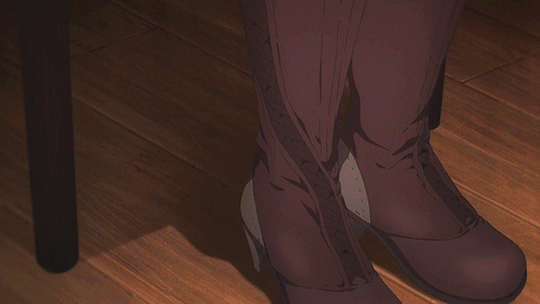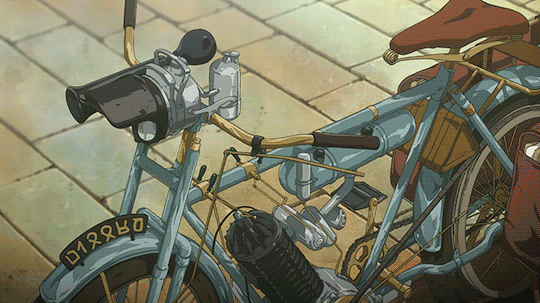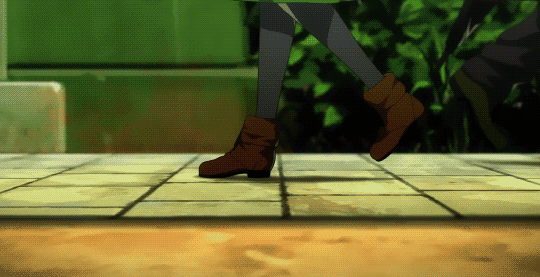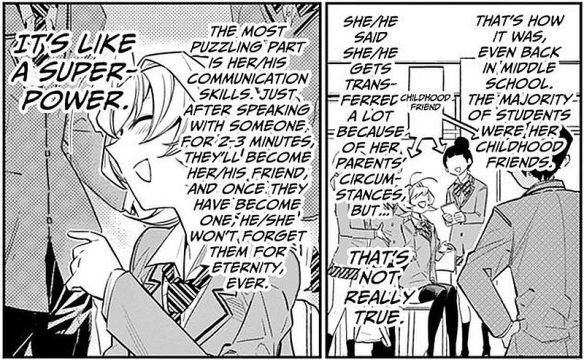
Warning: Violet Evergarden spoilers ensue:
We are 3 episodes into Violet Evergarden and so far it is a loving mix of beautifully rendered scenery, slow character development and jarring holes in the world-building, back-story and characterization. I must tread lightly so as not to sound like I am picking at it, rather than trying to squeeze past the discontinuities while still enjoying the story.

As a whole, Violet Evergarden remains charming and a must-watch for the season; the turn-of-century quasi-European city setting is almost as attractive as the terraformed Neo Venezia of the Aria opus. No one would pick Aria apart, that tale is too satisfying. At the same time, Aria‘s world building and characterization is a lot tighter. There are far few holes to pole a canal boat through. Even Cait Sith can’t break the spell.
With Violet Evergarden, we have troublesome bugaboos, even if they are the kind of thing that one presumes the Japanese anime viewer and/or light novel reader wouldn’t waste a second on – any more than they would fixate on the consistent use of flight technology in Studio Ghibli’s Castle In the Sky. If Violet is to join a profession that will have her and her women co-workers referred to as “Auto Memory Dolls”, beyond any presumed clunky translation effects and problems of reconciling the anime to the light novels, such fanciful conceits are completely within the rights of the author. It could have been stated that in this fantastic turn-of-century quasi-Europe, the profession of typist & public stenographer is called “Giant Robot Cake Chef” and thereafter have no giant robots, kitchens or cakes anywhere within the storyline. Fantasy turn-of-century quasi-Europeans just do that kind of wacky thing (see also: pants, below).
But of course there is more to this. I suspect that Violet’s profession was given its odd name specifically for Violet’s benefit, for the atmospherics surrounding her story – though of course, not –within– the story. In the light novels, there apparently was something about an inventor who created a machine to help his wife when she was stricken with an illness. Episode 2 briefly alludes to this; mentioning the inventor, his author wife who went blind and a machine he invented, all while holding on a still image of a typewriter with a doll behind it.
“Auto Memories Doll: Quite some time has passed since this name created a commotion. Professor Orland created a machine to record human speech. Originally made just for his beloved wife, the machine quickly became popular worldwide and an organisation offering rentals was also established.
“If a customer so desires it, I will hurry to wherever they are. I am Violet Evergarden of the Auto Memories Doll Service.” Says a blonde-haired blue-eyed woman, looking as though she’s stepped out of a story, in a voice sweetly ringing with robotic beauty.”
— per show synopsis: https://honeysanime.com/violet-evergarden/
Some confusion between the light novels and the anime adaption has crept in. Why bother about it any more than bothering about the other jarring incidence of “just-so”; Violet’s prosthetic arms and hands? Before she gets down to some serious speed-typing, Violet rolls up a sleeve and changes a setting or adjusts the tension on her mechanical elbow. Violet’s mechanical arms and hands are far in advance of any of the other technologies shown in the story. Was the original doll some similar manner of steampunk techno-magical text-recognition automaton that was not made available in the production model? Once again, the question is moot to the story. Such discontinuities are even characteristic of Contemporary Japanese pop narratives; almost as if the fuzzy parts are dropped in as a hook and/or for reader enjoyment. What is important is the atmospherics; the feeling that the profession’s name casts upon the lead character who is seeking her personal redemption within it. What better way to ease an asocial over-trained girl-child soldier back into civilian life, mechanical limbs and all, than as a pretty, emotionless and partially mechanical “doll”?
We must postulate that the eventual “good ending” of Violet’s story is that she finds her “humanity”; an empathetic, socially aware sense of self that will incidentally be appropriately gendered to the larger society she moves within. Of course, she will still be lethal in a close fight but she will be able to understand love, be again loved and be able to return such feelings as a full human being. To highlight how far she has to go, the story has done a simple trick during episodes two and three:

It has turned her into Full Metal Panic‘s Sagara Sousuke.

This is a wonderful economy of storytelling because we not only get a taste of Violet ‘The Weapon‘ in a civilian setting but we see her accommodation to her war injuries contrasted to those of Luculia’s brother; a wounded warrior who has become a traumatized, survivor guilt-ridden drunk. Again; Violet is immune to PTSD because her barebones instrumental war-child “self” is in itself a far greater trauma.

Kaaaaa-shim!
And yet, the flash of empathy towards a fellow wounded soldier and her characteristic economy of words come together to write the letter that Luculia needed to give to her brother and that her brother needed to read so as to begin working towards recovery. This breakthrough as well redeems Violet’s efforts at the Doll Academy, awarding her the delayed graduation along with her first successful commission. Perhaps she also wins an awareness of the condition of an “other” grounded in, or at least resonant to her own condition. This is “the writing of self through the writing for (and of) others” that I mentioned previously as the over-arching theme of the story and what makes Violet Evergarden stand out from mundane “What is this thing called Love?” Beautiful Fighting Girl grinders.
Episode 3 advanced with a mechanical precision and economy reminiscent of Violet’s hands and demeanor. An Auto Memory Doll is not a Lacanian psychoanalyst who practices the “short session” while they type letters. A letter can by necessity only provide momentary comfort to those who request and those who receive them. The second episode took the time to introduce the characters and position Violet as completely at a loss to understand civilian social interaction – and still deeply fixated on the memory of her commanding officer, Gilbert Bougainvillea. The third begins in earnest the pattern for the next few episodes. It does so well, playing to Violet’s experience as a soldier as her first point of empathy with a client, allowing her to write the letter that was needed and that few, perhaps none of her coworkers would have been able to write. The moment before she hands Luculia’s brother the letter, deflecting his crutch blow with her metal arm was a masterstroke of understated symbolism.

Meanwhile, the plotting hole or narrative space of the “Doll” term looms, whether or not there were advanced steampunkish magic-technological robot maid secretary typists that were supplanted by cheaper flesh and blood women behind a machine that presses type to paper. Her declaration; “If a customer so desires it, I will hurry to wherever they are. I am Violet Evergarden of the Auto Memories Doll Service.” carries with it uncomfortable undertones of gendered selflessness/ “un-selfing” within a gendered profession which further complicates Violet’s project of creating/ writing her own self. Then again, sex role expectations are already being messed with in the nation of Leidenschaft; her male patron’s first name is Claudia and the guy stripper pants and high heels on the delivery rider Benedict are almost as much of a hoot as the dangerous putt-putt moped he drives.
 For me, the wonky moped cinched the show. I had one something like it in my youth. Restored to somewhat ride-able condition from “basket case” condition while out west then crated up and brought home, I even found an old-stock OEM over-size piston and bored out the engine with the help of a friend who was heavily into classic English cars. I then drove it around town enough for it to try to kill me a couple of times before it was stolen out of my garage one night.
For me, the wonky moped cinched the show. I had one something like it in my youth. Restored to somewhat ride-able condition from “basket case” condition while out west then crated up and brought home, I even found an old-stock OEM over-size piston and bored out the engine with the help of a friend who was heavily into classic English cars. I then drove it around town enough for it to try to kill me a couple of times before it was stolen out of my garage one night.
The episode 2 scene with Benedict’s putt-putt moped threw me into a fit of nostalgia and occasioned hours of net-searching until I was able to find pictures and then a video of a 1952 Villiers New Hudson. Note the handle-bar arrangement: they are prone to vibration-induced metal fatigue and can snap off at speed. Meanwhile the lever throttle control remains wide open. Lunge forward, grab the front fender, hit the fuel cut-off with your knee and hang on for your life until the evil thing coasts to a stop 3 blocks later.
It didn’t corner for shit either. Skidded over nicely though…
I don’t miss it at all. I am alive today because it vanished into a long-past night. Still, I am a sucker for any anime with something similar in it.

High heels? Ventilated Chippendale’s pants? WTF?



































